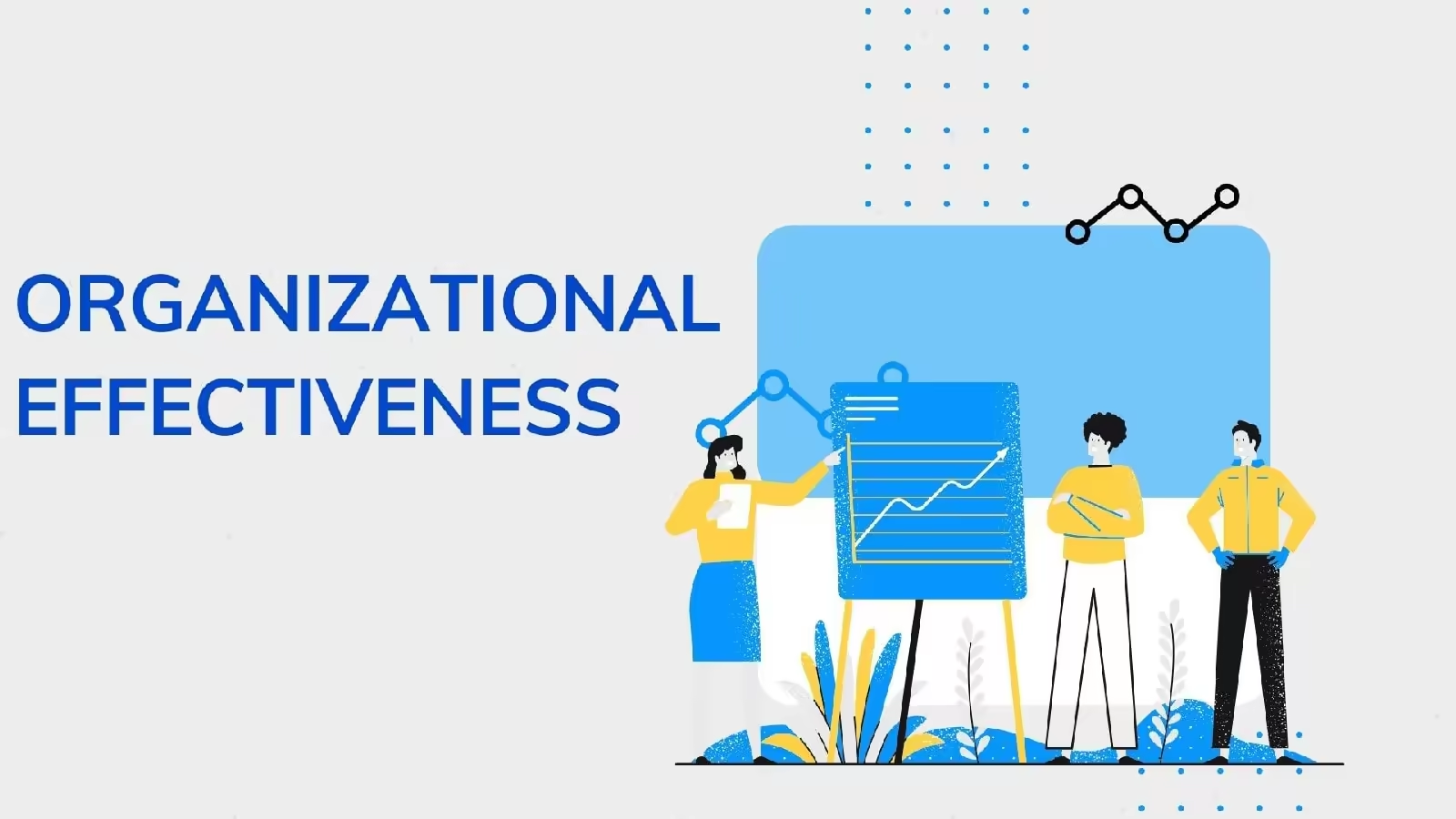Organizational effectiveness is a metric that assesses how successful an organization is in achieving its objectives. A well-functioning organization works smoothly. In this article, I will go through the components that make up a successful organization. Read on to learn how to make your company perform (even) better, whether you're a leader or in a more operational capacity.
I will define organizational effectiveness, then go through seven different organizational effectiveness models and how to assess organizational effectiveness.
What is organizational effectiveness?
(https://www.aihr.com/blog/organizational-effectiveness/)
Organizational effectiveness is a term that measures an organizations efficiency in achieving its goals with limited resources and without placing an excessive burden on its people. Its about how well the firm can meet its product quotas, how effective its processes are, and how much waste is generated.
Organizations are effective when they:
- Have access to the appropriate – and sufficient – resources.
- Have employees that are enthusiastic and willing to work together.
- Can successfully implement and achieve strategic goals set.
Impacts of organizational effectiveness include:
- The significance of business processes
- Output and productivity
- Profitability
- The ability of a company to achieve its objectives.
- How successfully a company serves the demands of its constituents
7 Organizational Effectiveness Models
- The goal method assesses effectiveness by determining how well an organization achieves the objectives it set out to achieve. This is the most common method of determining an organizations effectiveness. Product or service quality and quantity, financial goals, shareholder value, societal effect, or all of these are examples of goals. The goal method is less actionable because it assesses outcomes but does not give information about input or process.
- The internal process model examines what occurs within the organization rather than the output. This method evaluates effectiveness by looking at how well an organizations operations run. Information management, documentation, and ongoing consolidation are used to accomplish this.
The lean process strategy, which focuses on continual improvement and efficiency, is the most well-known example. The disadvantage is that the emphasis is generally on efficiency rather than effectiveness and internal procedures rather than external opportunities. - The input is used as a measure of effectiveness in the resource-based approach. According to the Resource-Based View (RBV), firms get a competitive edge by utilizing resources that are precious, unusual, and difficult to mimic or copy.
- The strategic constituency model evaluates success by determining how well it satisfies those in the environment which may jeopardize its existence - i.e., its strategic constituencies or interest groups. Each group has a different level of authority and pursues distinct objectives.
Owners, management, workers, consumers, suppliers, government, and customer groups are examples of constituencies. Its critical to identify the crucial strategic constituencies and their expectations and how to satisfy them. - The stakeholder method is a similar concept, and this comprises strategic stakeholders and individuals who are influenced by the organization but do not have authority over it (e.g., families of workers, activists, and communities).
- Cameron and Quinns competing values framework provides the foundation for the competing values model. This method assesses an organizations success by looking at its capacity to promote competing ideas simultaneously.
An organization may, for example, want to satisfy customers and maximize profits while also caring for employees, promote internal structure and coordination while also encouraging innovation and novel initiatives, and have a clear direction while also giving people autonomy to help the organization get there. The capacity of a company to balance these conflicting principles is critical to its success. - According to the abundant model, effectiveness translates to human systems reaching their full potential. Its all about promoting positive ideals and virtuous behavior. To achieve this successfully, a balance of positive and negative numbers is required. Excellence and thriving, for example, are impossible to accomplish without facing challenging difficulties and overcoming obstacles. To push the capacity of human systems, both positive and negative aspects and emotions are necessary.
Measuring organizational effectiveness is not a matter of either/or. Instead, it is about taking multiple perspectives and seeing if the organization is reaching the goals it set out to achieve and its full potential.
How to measure Organizational Effectiveness
Organizational effectiveness models offer a different viewpoint on evaluating OE. Well need to build a complete scorecard if we want to measure it. This establishes a systematic strategy that can be utilized regularly to re-evaluate and measure progress on the organizations effectiveness and areas for development.
According to Cameron (2015), the following five questions can be used to evaluate organizational success. The activity domain and viewpoint, as you may recall, are what make up the effectiveness models we discussed in the preceding section.
- The realm of activity. What is the scope of the actions that OE evaluates? Goal achievement, stakeholder satisfaction, financial return, staff loyalty, product leadership, consumer intimacy, and so on are examples of activity domains.
- Perspective. Who is evaluating the efficiency of an organization? A shareholder viewpoint, an employee perspective, a consumer perspective, or a social perspective are all examples.
- Analytical level. Which degree of analysis is appropriate? This can apply to an individual, a group, a department, an organization, an industry, or even the whole world.
- Time limit. What is the period for the investigation? This might be for a specific period in the past, a snapshot of the current organization, or a long-term trend timeline.
- A reference point. What is the effectiveness evaluations frame of reference? The company might be compared to its ideal, rivals, previous versions, or declared objectives.
These questions enable you to quantify a particular perspective on organizational effectiveness.
How Can Businesses Become More Effective?
Making a company more efficient entails:
- Streamlining business procedures. Reduced costs, faster turnarounds, and higher process ROI benefit better, more efficient processes.
- Employee interactions are being improved. Employee interactions are a significant determinant of a companys success. Interpersonal conflict may be reduced, and collaboration can be improved, enhancing performance across the board.
- Developing worker abilities. Any employees ability to perform successfully is contingent on having the appropriate skills. This is especially true today with the rising digital skills gap and the growing need for digital literacy.
- Improving the working environment for employees. Improving employee experience is another approach to boost productivity. Employee happiness, output, and motivation may all benefit from better employee experiences. All of this will increase their effectiveness as well as the effectiveness of the company.
- Aligning business functions with the overall strategy of the firm. Business operations that arent associated with the organizations core goals might accomplish goals that arent aligned with the organizations main aims. This strategy is unproductive and wasteful of resources.
- Developing an appropriate employee culture and behaviour. What individuals think and value is defined by their culture. Certain sorts of talent, attitudes, and mindsets are attracted to corporate cultures. By enhancing behaviour, the correct culture may boost efficiency and effectiveness.
A Step-by-Step Method for Achieving Organizational Effectiveness
- SELECT A MODEL FOR ORGANIZATIONAL EFFECTIVENESS. The first step toward successful change is to define organizational effectiveness. You wont set practical objectives or processes until you understand how to view organizational success.
- EXAMINE THE VARIOUS ELEMENTS OF YOUR MODEL. Make evaluations of each component of your model. For example, using a goal-based approach would evaluate your business units, processes, people, and strategy. Then look for flaws, strengths, and places where you may improve.
- TO IMPROVE SUCH COMPONENTS, DEVELOP CHANGE MANAGEMENT STRATEGIES. The process and discipline of implementing organizational transformation are known as change management. Regardless of your system, achieving organizational performance necessitates effective change management tactics.
- EXECUTE AND MONITOR YOUR CHANGE MANAGEMENT STRATEGIES. Execute your plan after youve established goals and a change management approach. Make sure you employ a comprehensive, organized management technique, just like you would with any other project. How successfully you implement your change project will have a significant impact on the outcome of your project.
REVIEW AND MAKE ANY REQUIRED CHANGES. Review and examine your project regularly. You can use data, analytics, KPIs, and metrics to track your success. Then make modifications to keep your project on schedule and track to success.
Organizational effectiveness examples
An organizations effectiveness is determined by its mission and goals, internal efficiency, strategic positioning, and a variety of other elements.
(https://www.aihr.com/blog/organizational-effectiveness/)
Three organizations are depicted in the diagram above. Which organization do you consider to be the most effective? Each has a measurable beneficial impact on its shareholders, users, employees, or the environment. As a result, every one of them is successful in their manner.
Yolanda Chimonyo is a Strategy and Performance Management Consultant at Industrial Psychology Consultants (Pvt) Ltd, a management and human resources consulting firm.
Phone +263 242 481946-48/481950
Email: yolanda@ipcconsultants.com
Visit our website at www.ipcconsultants.com

